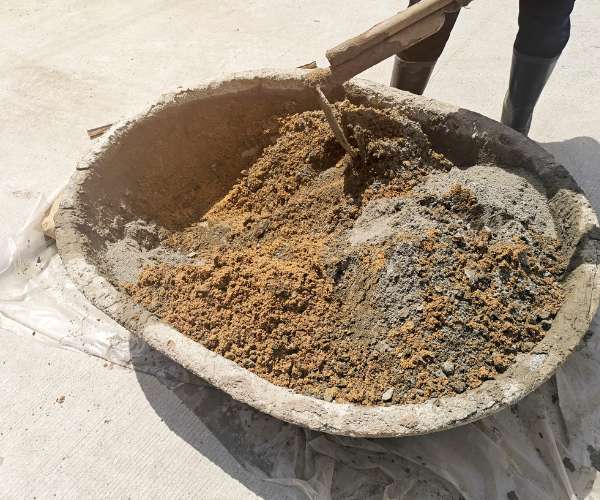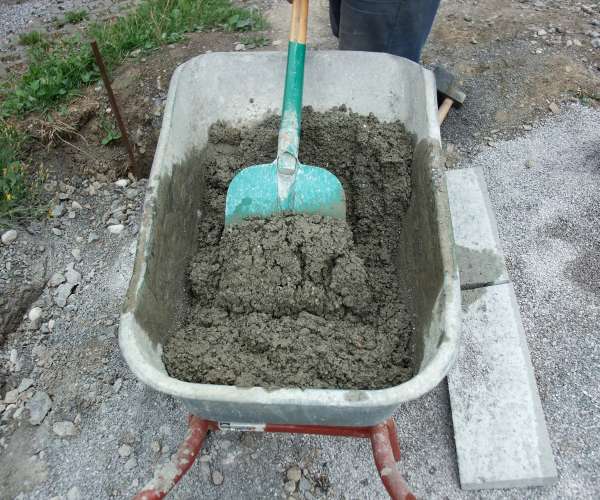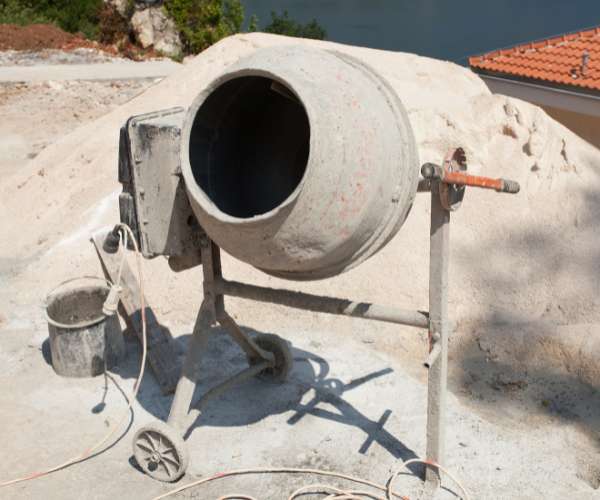How to Mix Concrete for Construction Projects in the UAE

March 13th 2024
The UAE's construction landscape thrives on innovation and expertise. While buildings rise high and projects break ground, understanding the fundamentals, like concrete mixing, is crucial for long-lasting structures.
Improper mixing can lead to unseen risks, jeopardizing the very strength and resilience these projects represent.
How to mix concrete for construction?
Mixing concrete involves precisely combining essential ingredients: cement, aggregates (sand and gravel), and water. You need to perform this process either manually or with the help of reliable machines to ensure efficiency and consistency.
There are seven common steps to mix concrete for construction:
- Measure and batch the essential materials: cement, aggregate (sand and gravel), and water.
- Add the cement, sand, and gravel to a concrete mixing tub or drum.
- Add water regularly when mixing with a shovel or concrete mixer.
- Mix the materials until you get a regular, workable concrete mixture.
- Use the mixed concrete within the recommended time frame, generally 30–60 minutes.
- Pour the combined concrete into the desired mold or form, or use it as needed.
- Allow the concrete to cure completely, following the recommended curing schedule.
Precise concrete mixing ensures a uniform, robust base, just like the knowledge you build empowers your success in the dynamic UAE construction sector.
A Pro Tip for the UAE:
For first-time mixers, consider using pre-blended bagged concrete mix. This convenient option eliminates the guesswork and potential errors associated with manual mixing. Popular choices in the UAE include Weberep products like Weberep 331 TX Concrete Repair and WeberPremix SRC 2 Ready Mix Plaster. These products require adding water, making them ideal for small to medium-sized projects.
Calculate the quantity based on your project size (bagged mixes typically range from 25-50 kg), and you're ready to go!
Methods of Mixing Concrete
As we told you in the beginning, there are two techniques for concrete mixing. The choice of method is dependent on the scope of the construction project. Let's talk about them one by one:
1. Hand Mixing:
Hand mixing offers a budget-friendly and effective solution for minor construction or renovation projects. This timeless technique, honed over generations, requires physical effort and dedication. Imagine the satisfaction of shaping the very foundation of your project with your own hands.
2. Machine Mixing:
Hand mixing becomes impractical for larger-scale construction projects demanding significant quantities of concrete. Therefore, for more extensive and commercial projects, you need the power of machine mixers. Machine mixers, categorized as batch or continuous mixers, handle the heavy lifting, ensuring consistent and efficient mixing.
The ideal method depends on the project size and your desired level of control. For smaller DIY projects, hand mixing can be a rewarding experience. However, machine mixing offers increased efficiency and consistency for larger endeavors, ensuring your project stays on track.
How to mix concrete manually?
Manual concrete mixing looks complex, but it's not that complicated. If you follow the steps, you can get a stable foundation for a building.
Manual concrete mixing entails the regular mixing of various materials that determine the shape's amiability, energy, and sturdiness. These ingredients encompass water, a coarse aggregate, a fine aggregate (sand), components, and good-quality cement for concrete use.
Since every factor includes one-of-a-kind bodily and chemical properties, checking those components before mixing is essential. The presence of the following components commonly identifies an appropriately mixed concrete:
- It must have uniformity in colors.
- It must obtain the right consistency.
- It should seamlessly combine components.
- It should easily cover up all of the surfaces.
How to mix concrete in a bucket?

Now, let's talk about real-life use cases. You can even mix concrete in a bucket for minor construction or repair work. It's best for smaller projects requiring 12–15 kg of concrete or less.
To mix concrete in a bucket, you'll need the following:
- Plastic bucket or utility tub (five-gallon capability or larger)
- Margin trowel or an energy drill equipped with a paddle mixer attachment (optional)
- Measuring a pail or empty gallon milk jug (not essentially required; however, those are on-hand gear for measuring and measuring out water)
Step-by-step procedure to mix concrete in a bucket:
- Dump the specified quantity of bagged mix into the bucket, shape a depression inside the middle of the combination, and then slowly pour approximately 3-quarters of the water consistent with the package directions.
- If you don't need to use the complete bag, keep in mind to regulate the quantity of water as a result.
- Mix the materials slowly with the trowel or paddle mixer, and pour in the rest of the water as needed.
- The less water you use, the more potent the concrete could be, so best add the amount necessary to acquire a workable consistency.
How to mix concrete in a wheelbarrow?

A wheelbarrow is suitable for medium to large-scale construction projects. It's best for projects requiring 25–40 kg of concrete.
To mix concrete in a bucket, you'll need the following:
- Wheelbarrow
- Garden hoe or flat shovel
- Hose with a spray nozzle
A step-by-step method to mix concrete in a wheelbarrow:
Follow the same procedure as you used in bucket mixing. You can use the hoe for incorporating as a replacement for the trowel.
How to mix concrete with a portable mixer?

A portable mixer is best for larger projects requiring multiple bags of mixed concrete.
To mix concrete in a portable mixer, you'll need:
- Portable concrete drum mixer or mortar mixer (these are frequently available for rent in capacities ranging from 3.5 to 9 cubic feet)
- Wheelbarrow for transport of the mixed concrete to the construction site.
Step-by-step process to mix concrete in a portable mixer:
- Dump the bags of mixers you're using into the drum and add approximately 3-quarters of the water recommended on the package.
- Then turn on the mixer and mix till the materials are mixed, gradually including the water as vital until you achieve a uniform consistency.
- Be careful not to add too much water; use the handiest thing you want for the mix to float freely out of the drum. Also, don't overload the mixer.
- You'll want at least one cubic foot of mixer potential for every 25-kg bag of concrete blend.
How to mix concrete: Troubleshooting
There are some standard precautions that you need to take in the process of mixing concrete:
- Clean the base platform before making each distinct concrete mix.
- Check for consistency. Take a small chunk of the concrete mix in your hand and hold it tightly. If the mix is not slipping from your hand and retains its form, it's the right mix.
- Adding excessive water to a bagged mix is the most common mistake when mixing concrete. Although water makes concrete workable, withstand the temptation to add more water than you want.
- Many of the issues with concrete are due to immoderate water, shrinkage, poor strength, and cracking.
- Ideal mixing of the concrete is also critical, particularly if you're mixing by hand. As a preferred rule of thumb, you want to achieve a uniform, moldable consistency like peanut butter or thick pancake batter.
- Ensure no dry packets or clumps of material are in your mix.
How to mix concrete: Safety Tips
Whether you are mixing concrete by hand or in a drum mixer, it's essential to take the following recommended safety precautions to avoid skin contact or lung and eye infections:
- Wear rubber gloves: Wear alkali-resistant rubber gloves and lengthy sleeves when mixing or handling concrete. Reactions from direct skin contact with moist concrete for extended intervals can range from mild irritation to more extreme burns. Buy the best quality rubber gloves here.
- Wear a disposable dust mask: Inhaling dirt from dry concrete can irritate your throat and lungs, and frequent exposure to concrete dirt may even result in lung infections. Therefore, wearing a disposable dust mask when mixing concrete is essential. You can order this effective disposable dust mask from FEPY.
- Wear safety glasses: This is the most effective way to guard your eyes from exposure to concrete dust and shield them against splatter from wet concrete. There are a wide range of safety glasses available at FEPY.
Final Words
Now, you know how to mix concrete. Remember to use the best quality products available to you in the UAE. Several products can make your job easier while mixing concrete. For example, Techno Plast Mix Plaster Admixture is a liquid additive used to improve the workability and properties of plaster mixes. You can buy it from FEPY. And if you are involved in repairing work, you can use bonding agents. These are used in concrete to improve the adhesion between concrete and other materials.
FAQs
What is the cement, sand, and combo ratio in concrete blending?
The cement, sand, and aggregate ratio in concrete blending is typically 1:2:3. Still, it can vary depending on the concrete's precise application and desired strength.
How much water should I use even when mixing concrete?
The amount of water to apply, even if mixing concrete, will depend on the dryness of the combination and the preferred consistency. A famous rule of thumb is to use sufficient water to make the aggregate wet but not runny.
How much time do I need to combine concrete?
Mix concrete until it is consistent in color and with no visible streaks of cement. The time needed to achieve this depends on the mixer used and the amount of mixed concrete.
What distinguishes ready-mix concrete and concrete mixed on the construction site?
Ready-mix Concrete is mixed at a particular location, batched, and transported to the construction site. Fresh concrete, also known as concrete mixed on site, is batched at the site and used immediately for construction.
How do I ensure that the concrete mix is robust and sturdy?
To ensure that your concrete blend is robust and sturdy, use a suitable ratio of cement, sand, and aggregates, and ensure each material is free from contaminants. Ensure you cure the concrete adequately by providing sufficient moisture or applying a curing compound.
How do I calculate the amount of concrete I need?
To calculate the amount of concrete you want, you'll need to measure the areas and intensity of the concrete slab or shape you're constructing. Use the formulation volume = length x width x depth to calculate the general quantity of concrete needed.
Can I add any admixtures to my concrete mix?
Yes, admixtures such as air-entraining agents, delaying agents, and accelerating agents can be added to the concrete mix to improve its quality. For this, there are several products available at FEPY.